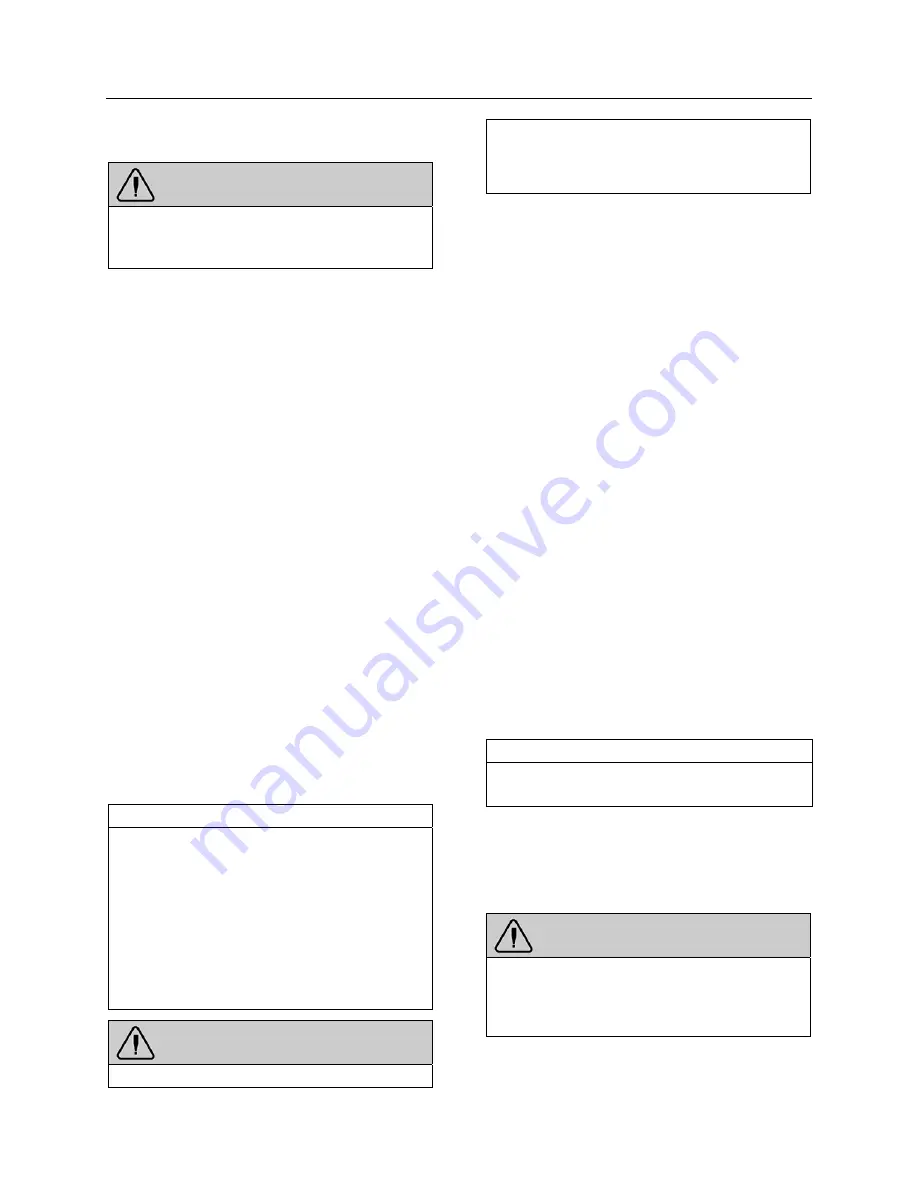
Care and Maintenance
PA1627 X3-45 Operator’s Manual
8-13
due to lost fluids. Treat fuel and oil leaks as an
immediate fire hazard.
WARNING
Personal injury and property damage may
result from fire caused by leaking flammable
fluids.
Hose Service Life
Hoses have a limited service life. Thoroughly
inspect hoses annually. Look for surface
damage or indications of twisted, worn, crimped,
cracked or leaking lines. Replace damaged
hoses immediately.
Hoses should be replaced during major overhaul
or after a maximum of seven years service. Be
certain replacement hoses match the original
equipment manufacturer's specifications.
LUBRICATION
Grease all lubrication points during scheduled
maintenance. For heavy loads or extended use,
lubricate more often. Refer to the Maintenance
Manual, section 24 for information on
lubrication.
WHEELS AND TIRES
Check for loose wheel nuts. Inspect all types of
rims for cracks. Cracks can appear in many
places but typically radiate out from where a
load is applied. Both aluminum alloy and steel
wheel nuts should be tightened to 450 to 500
foot-pounds (610 to 680 N.m.) torque.
Keep the tires inflated to the recommended
inflation pressure to prolong tire life and for
safety.
NOTE
Recommended tire inflation pressures are
given in the "Coach Final Record", placed in
the technical publications package supplied
with the vehicle. The cold tire inflation
pressures are on the Department of Transport
certification plate located on the L.H. console
besides the driver’s seat. When special tires
are installed by Prevost on a new vehicle, a
special tire inflation chart is added next to the
certification plate.
WARNING
Do not exceed maximum inflation pressure.
Incorrect tire pressure increases tire wear and
could lead to loss of driving control because
of reduced road handling. Check tire pressure
regularly.
Vehicles equipped with BERU TPMS
On vehicles equipped with the Beru Tire
Pressure Monitoring System (TPMS), it is better
to use the TPMS display as the primary
reference to judge when tire pressure need
adjustment.
The TPMS presents pressure readings of each
tire as a +/- deviation from the wanted target.
If a tire reads /- 3 PSI no adjustment is
needed.
If a tire reads -4 PSI and below, re-inflate by the
marked amount.
If a tire reads +4 PSI and above , deflate by the
marked amount.
Relying on the TPMS system is better than
relying on a hand gage since the TPMS is
temperature compensated and remain accurate
no matter if the tires are cold or hot.
Tires take up to 3 hours to get down to ambient
temperature after a ride. A common mistake
consist of checking pressure while the tires have
not fully cooled down which leads into under-
inflated tires. Relying on the TPMS eliminate this
mistake.
Running tires at optimal pressure reduce tire
wear, improve safety and fuel economy.
NOTE
It is more accurate to use the TPMS display to
set the tire pressures than a pressure gauge.
WHEEL BEARINGS
Check wheel bearing cover for overheating
(especially after using the service brakes) during
fuel stops by touching the wheel bearing cover.
WARNING
If replacement tires are different from those
described on the certification plate, pressure
must be adjusted as requested in the Tire and
Rim Association Manual.
Summary of Contents for X3-45 2017
Page 1: ...OPERATOR S MANUAL X3 45 COACH...
Page 2: ......
Page 3: ...COACH MANUFACTURER OPERATOR S MANUAL X3 45 COACH Model Year 2018 PA1627 September 2017...
Page 8: ......
Page 12: ......
Page 28: ...Coach Exterior PA1627 X3 45 Operator s Manual 2 16...
Page 42: ...Coach Interior PA1627 X3 45 Operator s Manual 3 14...
Page 100: ...Controls and Instruments PA1627 X3 45 Operator s Manual 4 58...
Page 186: ...Care and Maintenance PA1627 X3 45 Operator s Manual 8 22...
Page 200: ...Technical Information PA1627 X3 45 Operator s Manual 9 14...
Page 202: ......






























